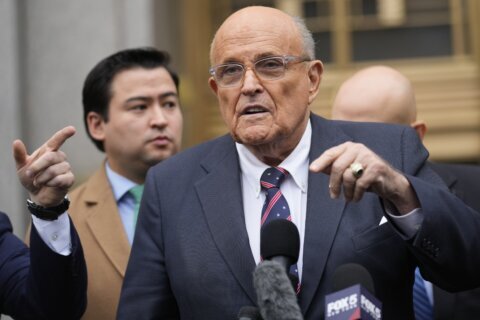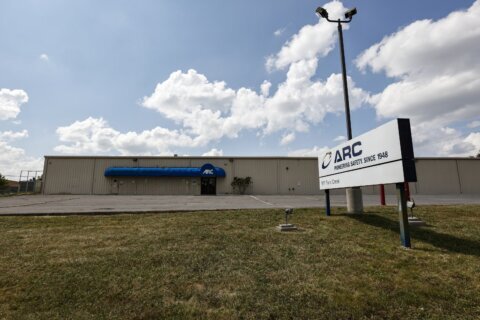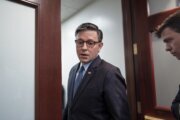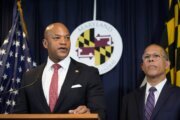KNOXVILLE, Tennessee (AP) — “That’s where I got shot,” said Rashaad Woods, nodding toward a convenience store in Knoxville’s “gun zone.” There were bullet holes in a church’s walls. Nearby was a shuttered nightclub where some people were killed.
“There was a point in time I wasn’t comfortable standing here,” said Kodi Mills, 45. “But that time is passing.”
The men work for Turn Up Knox, a year-old outreach program that mentors kids and defuses situations that could escalate into violence. It’s a centerpiece of the Tennessee city’s attempt to follow a science-based playbook in fighting a surge in shootings.
In recent years, research reviews have begun to conclude there’s enough evidence to say which public health interventions prevent shootings, which do not, and which need more study. Knoxville is one of a growing number of cities teaming with researchers to develop an evidence-based plan to stop the bleeding.
Knoxville’s program was in reaction to a dramatic rise in shooting deaths and includes policing changes and other efforts. However, it does not count on new gun restrictions. That was important, since Tennessee has repeatedly moved to loosen gun laws.
“I wanted to have answers,” said Knoxville Mayor Indya Kincannon. “I wanted to be able to fix it.”
___
Nearly non-existent not long ago, gun violence prevention research has experienced a small boom in the wake of mounting shooting deaths, expanded funding and burgeoning advocacy.
Two decades ago, only about 20 U.S. researchers were focused on gun violence prevention. Last fall, more then 600 gathered in Washington, D.C., for what’s been described as the largest-ever national conference on the issue. An even bigger turnout is expected at a conference this fall.
Funding continues to be just a fraction of what is spent on other leading causes of death. Still, research has “just exploded” in the last few years, said Rebecca Cunningham, a gun violence researcher at the University of Michigan.
The work addresses the worst firearm violence in decades. Researchers estimate there were more than 48,000 firearm deaths last year, with gun-related homicide and suicide rates not seen since the early 1990s. Gunshots are now the leading cause of death of U.S. children and teenagers.
Though some big questions remain, there is a growing consensus about what programs and policies make a difference — and which don’t.
According to an assessment by the Rand Corp., measures that work include laws that permit charging adults who let children have unsupervised access to guns, well-enforced background checks and policies that ban guns from people subject to domestic violence restraining orders.
Measures that don’t: stand-your-ground and concealed carry laws, which studies consistently show increase gun homicides, and gun buyback programs, which have been shown to have little, if any, effect on crime.
___
About 16% of Knoxville’s population is Black, and about 40% live in poverty, many in East Knoxville, where firearm violence has surged.
As in other U.S. cities, violence escalated during the COVID-19 pandemic, when adults were out of work, kids were not in school and people were anxious.
“It was a very unsettled time,” Mayor Kincannon said.
Before the pandemic, homicides hovered around 20 per year. That shot up to 38 in 2020 and rose again to 41 in 2021, giving Knoxville a gun homicide rate that rivaled Chicago’s.
As shootings accelerated, Kincannon turned to Thomas Abt, whose book, “Bleeding Out,” offers a plan for cities that includes having police and community organizations work together.
Crucially, Abt’s program doesn’t count on policymakers to take action to restrict gun access. That was appealing, because Tennessee’s state government has been moving in the opposite direction.
In 2021, the state started letting people carry handguns — visibly, or concealed — without a permit. This year, the minimum age for carrying handguns dropped to 18.
Even after a mass shooting that killed three children and three staff at an elementary school in Nashville this year, the state Legislature’s Republican majority fought calls for tougher gun laws. Two Black representatives who protested the inaction were expelled.
Gov. Bill Lee, a Republican, opened a special legislative session this week to address public safety. But many Republican lawmakers have spurned his centerpiece measure that would take guns away from people deemed an extreme risk to themselves or others.
Kincannon supports expanded background checks and other gun control measures, but said Knoxville’s efforts are designed to make a difference “no matter what happens legislatively.”
___
Several cities have began looking to team up with gun violence prevention experts, including Muskegon, Michigan, which partnered with the University of Michigan.
Knoxville became the first city to sign up with Abt’s program at the Center for the Study and Practice of Violence Reduction at the University of Maryland, which teamed with an outside researcher to analyze its violent crime.
The analysis contained a few surprises, said Knoxville Deputy Police Chief Tony Willis.
The average age of shooting suspects was 28, and for victims, 29, — an unexpectedly large proportion who were “much older than I expected,” he said.
Only 12% of homicides were solely gang-related, much lower than anticipated, Willis said. That suggests gun violence is often a personal dispute that could be mediated or averted before shots are fired.
The research also supported police data showing most gun violence happened in a few “hot spots,” mostly in East Knoxville, leading to a plan initially focusing police and community outreach to a nine-block area there.
The effort involves church leaders and a range of community organizations. There were also changes at the police department, including a new police chief, a detective unit focused only on homicides and shootings, and officers dedicated to patrolling in areas with many shootings.
A goal is to increase public trust in law enforcement, which had been low and sometimes abysmal. A particular low point occurred in 2021, when a police officer killed a student in a high school bathroom in East Knoxville.
“The community did, absolutely, raise concerns about policing. … A lot of conversations are still happening, frankly,” said LaKenya Middlebrook, the mayor’s point person on the effort.
Kincannon said she knew police “couldn’t do it alone.”
“We would have someone get killed in broad daylight, with a lot of witnesses, but no one wanted to talk,” she said. “That means we need more partnership in the community, to build trust.”
Even before the researchers’ analysis was completed, the city funded Turn Up Knox, a nonprofit led by 32-year-old community activist Denzel Grant.
It uses ex-offenders, violence survivors and other community members to identify those most likely to be shot or to become shooters in the future. They mentor teenagers, operate a lawn service that gives jobs to kids and are teaching families how to mediate conflicts and deal with the trauma that follows shootings.
Sometimes, when someone is in danger of becoming the victim of a revenge shooting they give them a bus ticket to get out of town for a few days.
Such outreach can be pivotal if it’s integrated with a trusted police force, responsive mental health services and other community efforts, Abt says.
It’s too early to say if the steps so far are making a difference in Knoxville.
There were 36 homicides last year, down from the 41 the year before. But firearm homicides fell nationally last year, and experts aren’t sure why. In the first six months of this year, Knoxville had 15 homicides, down from 18 in the same period last year.
___
Some experts have mixed feelings about the Knoxville approach.
Abt is “very respected” and focuses on immediate steps to reduce gun violence, but he doesn’t emphasize longer-term programs to alleviate poverty and racial disparities, said Jim Mercy of the U.S. Centers for Disease Control and Prevention.
The program also doesn’t directly address gun suicides, which outnumber gun homicides.
Some East Knoxville residents note the area has few stores, and few safe places for kids to have fun, and limited opportunities for summer jobs.
“Kids should have something to do,” said Chloe Isom, 41, who lost two sons to gun violence last year. JaBari, 16, was killed in September and 20-year-old Stephen two weeks later.
City officials have increased summer youth programs, serving hundreds of kids. But they acknowledge much still needs to be done and that Turn Up Knox needs more resources and training. Also, Kincannon faces a primary election on Tuesday.
“If she doesn’t get re-elected, that’s a scary situation,” said Terry Walker-Smith, 58, who works with Turn Up Knox and lost two sons to gun violence, in 2007 and 2009.
Charlene Roberts’ 25-year-old daughter, Jessie, was killed by a stray bullet in 2019 while sitting in a car at a North Knoxville fast-food drive-thru. Her son Kevin, 33, was killed in 2021 when gunfire erupted at a birthday party.
She is now raising Jessie’s son, Princeton.
Princeton is a quiet, basketball-loving kid who just started sixth grade and looks a lot like his mother. On his bedroom wall is a framed certificate, “Brightest Smile Award,” presented to him by a teacher a year before his mother was killed.
Besides losing his mother and uncle to violence, his father is in prison. Princeton has been bullied in school, his grandmother said. Princeton recalled a scary day when he saw people with guns just down the street.
“I wish they didn’t allow people to have guns,” he said. “I just don’t want to get hurt one day.”
His grandmother says he is resilient and “amazing,” but he’s also changed.
“He always had the biggest smile, just like his mother,” she said. “It breaks my heart. He fakes a smile now. He don’t have that smile anymore.”
___
The Associated Press Health and Science Department receives support from the Howard Hughes Medical Institute’s Science and Educational Media Group. The AP is solely responsible for all content.
Copyright © 2024 The Associated Press. All rights reserved. This material may not be published, broadcast, written or redistributed.







